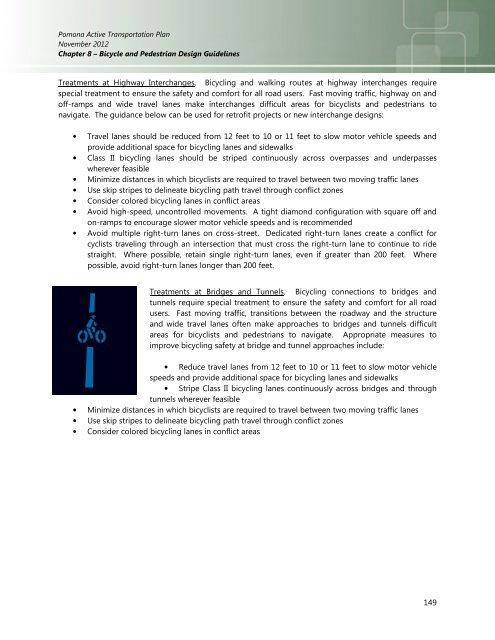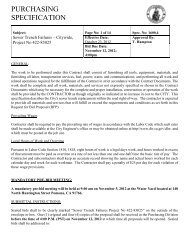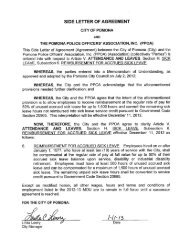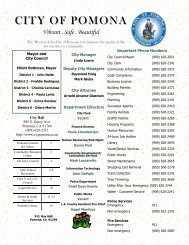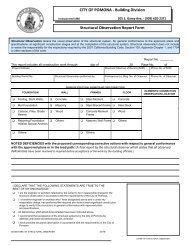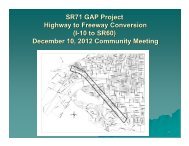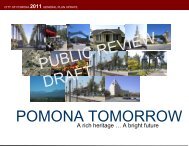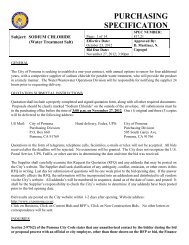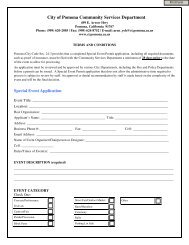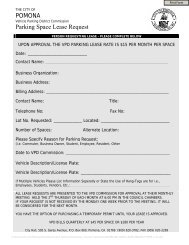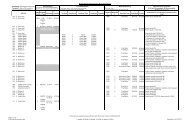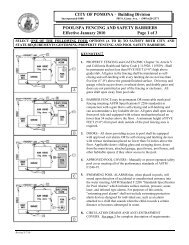Active Transportation Plan - City of Pomona
Active Transportation Plan - City of Pomona
Active Transportation Plan - City of Pomona
Create successful ePaper yourself
Turn your PDF publications into a flip-book with our unique Google optimized e-Paper software.
<strong>Pomona</strong> <strong>Active</strong> <strong>Transportation</strong> <strong>Plan</strong><br />
November 2012<br />
Chapter 8 – Bicycle and Pedestrian Design Guidelines<br />
Treatments at Highway Interchanges. Bicycling and walking routes at highway interchanges require<br />
special treatment to ensure the safety and comfort for all road users. Fast moving traffic, highway on and<br />
<strong>of</strong>f-ramps and wide travel lanes make interchanges difficult areas for bicyclists and pedestrians to<br />
navigate. The guidance below can be used for retr<strong>of</strong>it projects or new interchange designs:<br />
• Travel lanes should be reduced from 12 feet to 10 or 11 feet to slow motor vehicle speeds and<br />
provide additional space for bicycling lanes and sidewalks<br />
• Class II bicycling lanes should be striped continuously across overpasses and underpasses<br />
wherever feasible<br />
• Minimize distances in which bicyclists are required to travel between two moving traffic lanes<br />
• Use skip stripes to delineate bicycling path travel through conflict zones<br />
• Consider colored bicycling lanes in conflict areas<br />
• Avoid high-speed, uncontrolled movements. A tight diamond configuration with square <strong>of</strong>f and<br />
on-ramps to encourage slower motor vehicle speeds and is recommended<br />
• Avoid multiple right-turn lanes on cross-street. Dedicated right-turn lanes create a conflict for<br />
cyclists traveling through an intersection that must cross the right-turn lane to continue to ride<br />
straight. Where possible, retain single right-turn lanes, even if greater than 200 feet. Where<br />
possible, avoid right-turn lanes longer than 200 feet.<br />
Treatments at Bridges and Tunnels. Bicycling connections to bridges and<br />
tunnels require special treatment to ensure the safety and comfort for all road<br />
users. Fast moving traffic, transitions between the roadway and the structure<br />
and wide travel lanes <strong>of</strong>ten make approaches to bridges and tunnels difficult<br />
areas for bicyclists and pedestrians to navigate. Appropriate measures to<br />
improve bicycling safety at bridge and tunnel approaches include:<br />
• Reduce travel lanes from 12 feet to 10 or 11 feet to slow motor vehicle<br />
speeds and provide additional space for bicycling lanes and sidewalks<br />
• Stripe Class II bicycling lanes continuously across bridges and through<br />
tunnels wherever feasible<br />
• Minimize distances in which bicyclists are required to travel between two moving traffic lanes<br />
• Use skip stripes to delineate bicycling path travel through conflict zones<br />
• Consider colored bicycling lanes in conflict areas<br />
149


